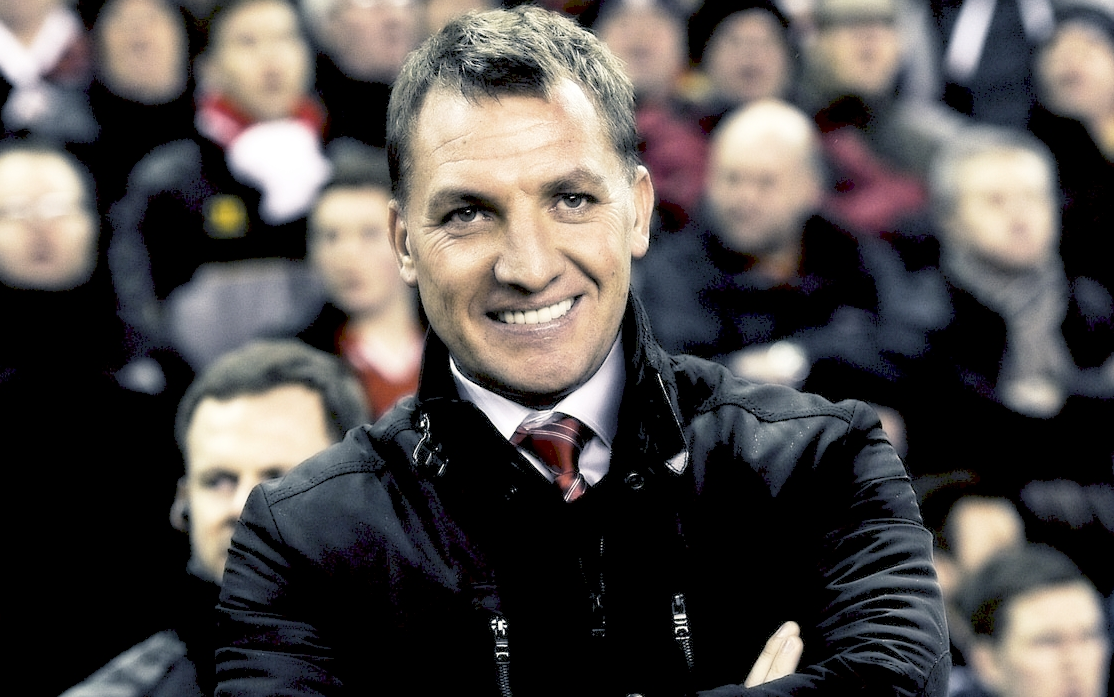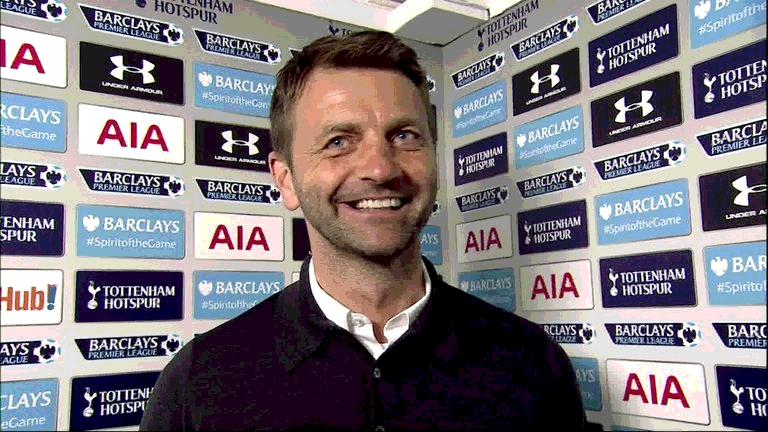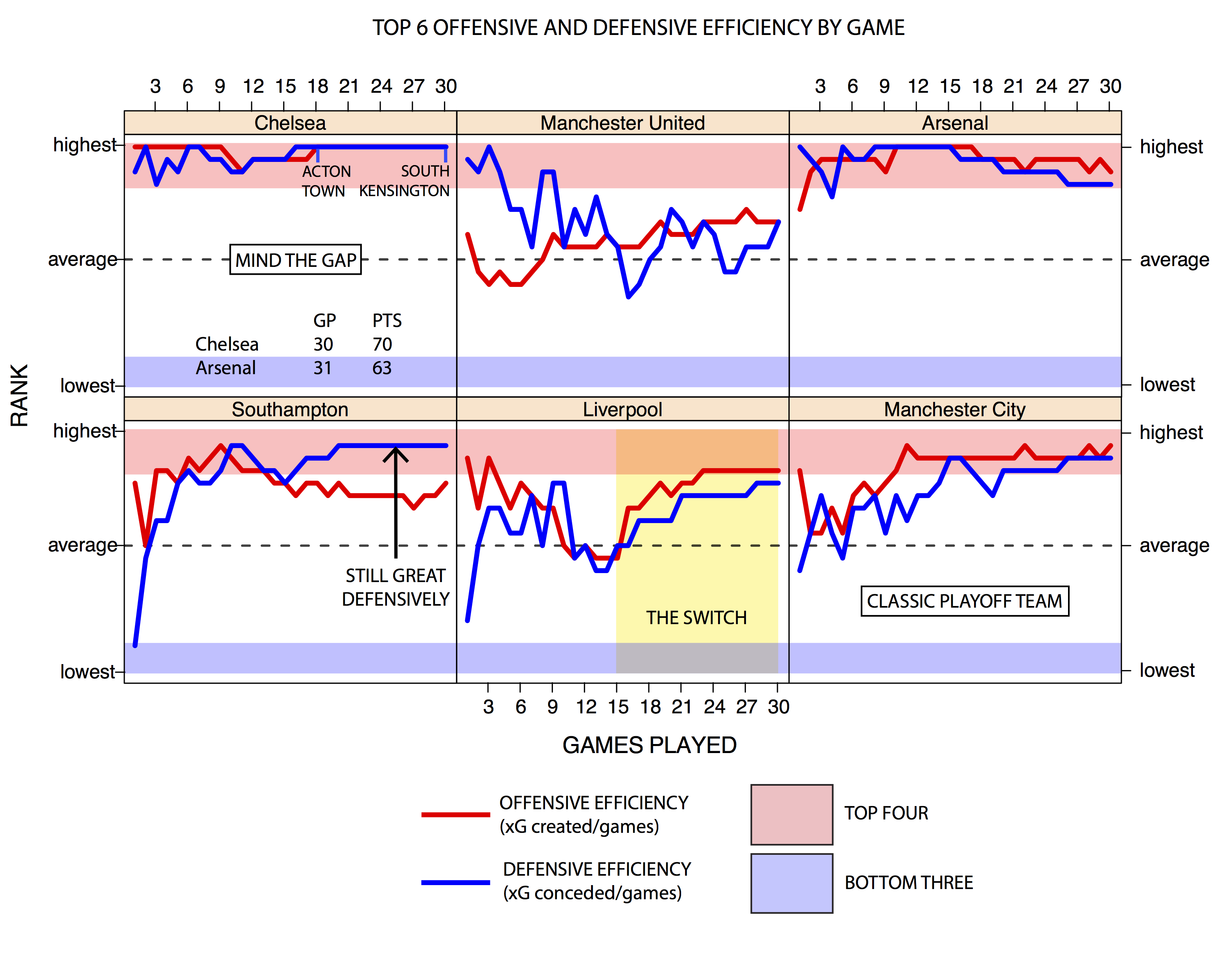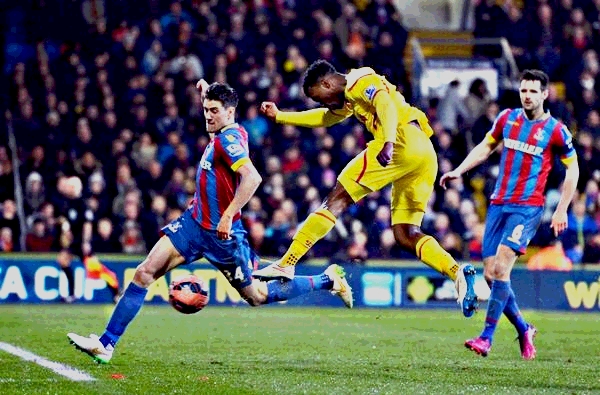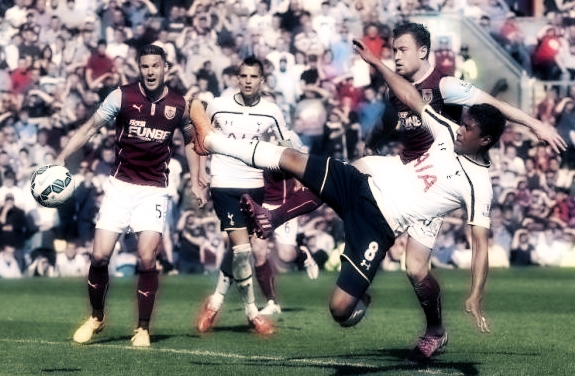A lot has been written about Liverpool in the aftermath of their meek cup exit to a Sherwood-charged Aston Villa, and a nil-nil draw, thwarted by the full Pulis has done little to ameliorate the prevailing fan mood. The reasons given for this season's “failure” have been extensive and variable with transfers, a lack of Suarez and Sturridge, too much tinkering with formations and even the fact that the 5th biggest club in the league is likely to finish 5th all being cited. The Liverpool fan base is huge and vocal and many thinkers and writers from the same generation have been brought up on a diet of success and quality throughout the 1970s and 1980s. Measures of success are at the high end here, multiple angles have been examined and much gnashing of teeth has taken place. As such it appears that Brendan Rodgers is under extreme external pressure in some quarters and with limited understanding as to how the analytically minded owners are perceiving his efforts, it is difficult to ascertain just how secure his tenure remains. In my world, it's as you were: replace Gerrard, sign up Sterling and if you are buying it's young, as close to the top end as possible or don't bother. Why? Because this season has not been as bad as it has seemed. A blend of numbers can show this: 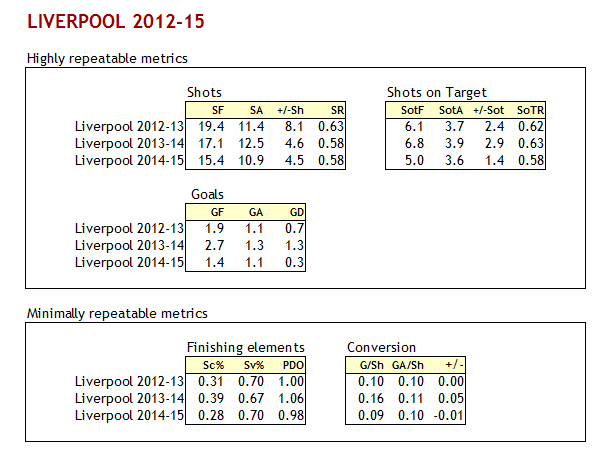 The general story from these numbers is that Liverpool have been broadly consistent over three seasons with regard repeatable shooting metrics. This is a good thing. A slight drop off this season can easily be attributed to the lack of Sturridge and Suarez, two extremely shot (and more recently, goal) heavy talents. The defensive numbers are consistent, if not better this year and by and large, Liverpool project season on season as a side that should be contending for the top four. That they have only achieved that once in the three seasons can be at least partially attributed to the non-repeatable metrics in the lower table. These are factors that are extremely difficult to influence. Where the defensive end has been broadly similar across these seasons the attacking numbers have varied from dizzily high in 2013-14 to around league average in the other two years. Of course Suarez was significantly more profligate in 2012-13 and had one of the great seasons last year. Talking of profligacy, does Balotelli deserve the benefit of the doubt? His goal total way undershoots any measured expectation this year and he hasn't suddenly become devoid of talent. I'd be inclined to persist with him provided he, or indeed any new potential goalscorer, can be fitted into any future system. Rodgers' eventual and current system hasn't empowered any of his forwards. Yet still they project like a superior side. There are a couple of specific areas where there has been an obvious deficit: in matches against rivals, they have conceded goals at a very high rate (17%) and in matches against the lesser teams, they have struggled to score at a high volume (9%, around 3-4% lower than direct rivals). Each of these aspects has been powered by factors that are likely to regress over a long term. In fact, it could easily be argued that this season is one long numeric counterbalance to the over achievement of last. The mad and goal laden enterprise of last year was a rare and unlikely star alignment and 2014-15 will not be remembered fondly but the time for genuine concern is when the basic production figures of shooting disappear. Whilst that isn't happening, tweaks and fluctuations will guide a team within likely parameters, and for Liverpool that means somewhere between 2nd and 6th. Given the many issues cited by fans looking in on the club and seeing that general performance levels have been almost sustained, I suggest relatively minimal tinkering could achieve more positive results next year. But there are never guarantees. There is a solid core of players at Liverpool and in Coutinho, Sterling, Ibe and Markovic they have four young attacking talents with extensive scope to improve. I remain skeptical of Rodgers' gifts as a man-manager but his general record is sufficient to deserve a crack at a post-Gerrard world. The lack of trophies is more a reflection of a changed landscape than of any fundamental structural deficiency. Now if only he could find away to get his forwards onto the pitch... Relegation update... With most of the juice in the league still centering on the trap-door, it's worth revisiting the bottom end for a quick update. Burnley, who haven't been good enough and haven't been getting the breaks managed to be not good enough and failed to get the breaks against Leicester. The slip on impact for their penalty was exactly the kind of cruel twist that you'd expect from the writer of a hacky soap opera. It is daft occurrences like this and Leicester's subsequent goal that lead even normally sane pundits to cite fate, a feeling also felt over at Loftus Road after their own penalty misery. Suffice to say, given these were critical home matches against par opposition, to see each team fail to win is to probably see them doomed. I hammered Sunderland last week for giving up tons of shots every time they played any strong team and they widened their generosity to present Stoke with plenty (23 to be precise). A solid point on the road? Not in the face of Hull winning the one game they absolutely had to against Palace and Villa again showing solid form despite defeat. Despite different nuance amongst the underlying numbers the bottom three now looks like the “right” three. The three with the worst defense, least goals or wins, the worst shots team, the worst two +/- shots teams and worst two shots on target ratio teams are all in there. In fact Sunderland and Burnley look ever more similar on the numbers, well: bad at both ends and QPR have just been far too carefree and porous. Obligatory Tottenham Split Personality
The general story from these numbers is that Liverpool have been broadly consistent over three seasons with regard repeatable shooting metrics. This is a good thing. A slight drop off this season can easily be attributed to the lack of Sturridge and Suarez, two extremely shot (and more recently, goal) heavy talents. The defensive numbers are consistent, if not better this year and by and large, Liverpool project season on season as a side that should be contending for the top four. That they have only achieved that once in the three seasons can be at least partially attributed to the non-repeatable metrics in the lower table. These are factors that are extremely difficult to influence. Where the defensive end has been broadly similar across these seasons the attacking numbers have varied from dizzily high in 2013-14 to around league average in the other two years. Of course Suarez was significantly more profligate in 2012-13 and had one of the great seasons last year. Talking of profligacy, does Balotelli deserve the benefit of the doubt? His goal total way undershoots any measured expectation this year and he hasn't suddenly become devoid of talent. I'd be inclined to persist with him provided he, or indeed any new potential goalscorer, can be fitted into any future system. Rodgers' eventual and current system hasn't empowered any of his forwards. Yet still they project like a superior side. There are a couple of specific areas where there has been an obvious deficit: in matches against rivals, they have conceded goals at a very high rate (17%) and in matches against the lesser teams, they have struggled to score at a high volume (9%, around 3-4% lower than direct rivals). Each of these aspects has been powered by factors that are likely to regress over a long term. In fact, it could easily be argued that this season is one long numeric counterbalance to the over achievement of last. The mad and goal laden enterprise of last year was a rare and unlikely star alignment and 2014-15 will not be remembered fondly but the time for genuine concern is when the basic production figures of shooting disappear. Whilst that isn't happening, tweaks and fluctuations will guide a team within likely parameters, and for Liverpool that means somewhere between 2nd and 6th. Given the many issues cited by fans looking in on the club and seeing that general performance levels have been almost sustained, I suggest relatively minimal tinkering could achieve more positive results next year. But there are never guarantees. There is a solid core of players at Liverpool and in Coutinho, Sterling, Ibe and Markovic they have four young attacking talents with extensive scope to improve. I remain skeptical of Rodgers' gifts as a man-manager but his general record is sufficient to deserve a crack at a post-Gerrard world. The lack of trophies is more a reflection of a changed landscape than of any fundamental structural deficiency. Now if only he could find away to get his forwards onto the pitch... Relegation update... With most of the juice in the league still centering on the trap-door, it's worth revisiting the bottom end for a quick update. Burnley, who haven't been good enough and haven't been getting the breaks managed to be not good enough and failed to get the breaks against Leicester. The slip on impact for their penalty was exactly the kind of cruel twist that you'd expect from the writer of a hacky soap opera. It is daft occurrences like this and Leicester's subsequent goal that lead even normally sane pundits to cite fate, a feeling also felt over at Loftus Road after their own penalty misery. Suffice to say, given these were critical home matches against par opposition, to see each team fail to win is to probably see them doomed. I hammered Sunderland last week for giving up tons of shots every time they played any strong team and they widened their generosity to present Stoke with plenty (23 to be precise). A solid point on the road? Not in the face of Hull winning the one game they absolutely had to against Palace and Villa again showing solid form despite defeat. Despite different nuance amongst the underlying numbers the bottom three now looks like the “right” three. The three with the worst defense, least goals or wins, the worst shots team, the worst two +/- shots teams and worst two shots on target ratio teams are all in there. In fact Sunderland and Burnley look ever more similar on the numbers, well: bad at both ends and QPR have just been far too carefree and porous. Obligatory Tottenham Split Personality 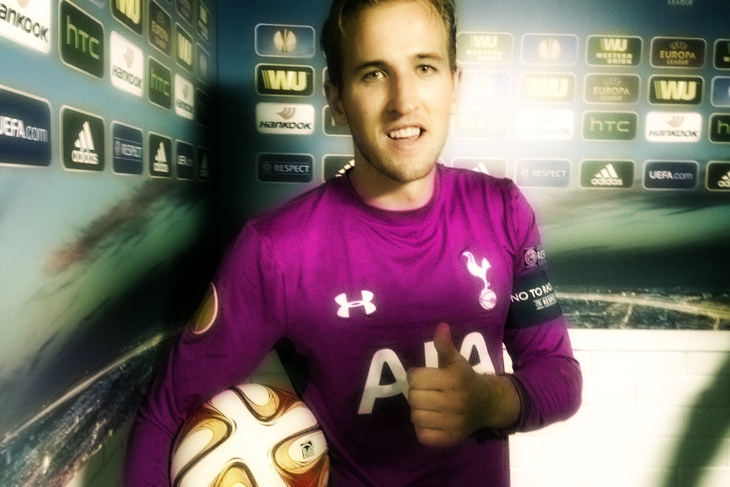 Carefree and porous could be the title of a chapter detailing the second half of Tottenham's season. PFA Young Player of the Year Harry Kane, Christian Eriksen and Nacer Chadli have now all hit double figures for league goals this year suggesting a marvellous attacking force that evokes memories of Ossie Ardiles' fanciful flying five but measured against wanton generosity at the back, so ably demonstrated by Ryan Mason and Ben Davies this week, it seems the Bielsa doctrine is being a little too readily heeded. Since the halfway point, there have been an average of 3.8 goals per game in Spurs matches (Tottenham edge the share 2.1 to 1.7) which is a ridiculously high number. There has also been a league high average of over ten shots on target per game (5.3 to 4.8) and conversion rates at both ends... and bear in mind I used this as a stick to beat him with and an example of his tactical inadequacy... higher than Tim Sherwood during either his Tottenham or Villa spells. (14% and 13% compared to 13% and 12%). That the team is now broadly level with it's position last year is no great surprise and whereas last year was one of coaching turmoil, it has become vividly apparent that this year is wholly and typically transitional. One thing struck me this week in the wake of an “insider” (see: tea lady) article on the club and that was the apparent permanence of groups of high earning “out-of-favour” players. This group, rotationally inhabited by Emmanuel Adebayor in particular, appears ever larger this season and it has been posited that these players will be “moved on” in the summer. That Villas Boas, Sherwood and now Pochettino have all suffered with failing to build a happy family is an all too familiar and unpleasant recent hallmark of player operations down at the Lane. Any clear-out is going to need to be necessarily quick and ruthless, as is recruitment, if only to maximise the return from the start of Pochettino's year two. This five-year plan has so far had a decidedly mixed impact; a purge awaits. ~~~~~~~~~~~~~~~~~~~~~~~~~~~~~~ Thanks for reading! Follow me on Twitter: @jair1970
Carefree and porous could be the title of a chapter detailing the second half of Tottenham's season. PFA Young Player of the Year Harry Kane, Christian Eriksen and Nacer Chadli have now all hit double figures for league goals this year suggesting a marvellous attacking force that evokes memories of Ossie Ardiles' fanciful flying five but measured against wanton generosity at the back, so ably demonstrated by Ryan Mason and Ben Davies this week, it seems the Bielsa doctrine is being a little too readily heeded. Since the halfway point, there have been an average of 3.8 goals per game in Spurs matches (Tottenham edge the share 2.1 to 1.7) which is a ridiculously high number. There has also been a league high average of over ten shots on target per game (5.3 to 4.8) and conversion rates at both ends... and bear in mind I used this as a stick to beat him with and an example of his tactical inadequacy... higher than Tim Sherwood during either his Tottenham or Villa spells. (14% and 13% compared to 13% and 12%). That the team is now broadly level with it's position last year is no great surprise and whereas last year was one of coaching turmoil, it has become vividly apparent that this year is wholly and typically transitional. One thing struck me this week in the wake of an “insider” (see: tea lady) article on the club and that was the apparent permanence of groups of high earning “out-of-favour” players. This group, rotationally inhabited by Emmanuel Adebayor in particular, appears ever larger this season and it has been posited that these players will be “moved on” in the summer. That Villas Boas, Sherwood and now Pochettino have all suffered with failing to build a happy family is an all too familiar and unpleasant recent hallmark of player operations down at the Lane. Any clear-out is going to need to be necessarily quick and ruthless, as is recruitment, if only to maximise the return from the start of Pochettino's year two. This five-year plan has so far had a decidedly mixed impact; a purge awaits. ~~~~~~~~~~~~~~~~~~~~~~~~~~~~~~ Thanks for reading! Follow me on Twitter: @jair1970
Month: April 2015
Who Is Getting Relegated From The Premier League?
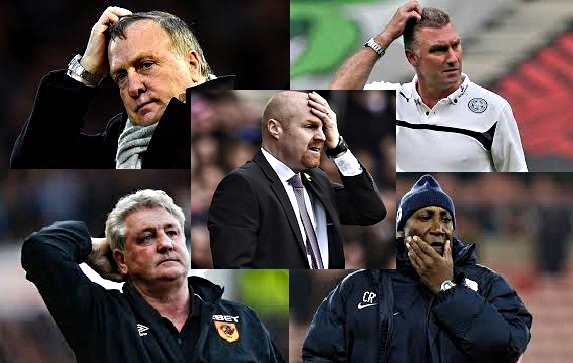 Relegation battles have destroyed many a prediction over the years. I condemned Sunderland at a similar point last season only for them to pull off a series of unlikely results to ensure survival and Wigan's repeated travails under Martinez prior to their eventual demise will have tested the most hardy cynic. It's tough to know how a team will respond as the spectre of impending relegation flickers ever more visibly in the corner of their sight but we do know a few things about them, namely: what they've done up until this juncture. Typically, team media narratives can get a little entrenched by this point in the season and without a stand-out terrible team this year, at least in terms of the vital metric of “points gained”, we are left with trap-door slightly ajar but as yet lacking sufficient pressure to force open. But who is toast? Who deserves nothing? There are bad teams in the league, for sure, and we're going to take a look at how bad they have been and what chance they have of recovering. As part of the never-ending search for insight, I spent a short while separating shooting numbers into “Top 7” and “The Rest” categories and some of the titbits I have picked up will inform the analysis. There are four wins and nine points between seventh and eighth; it's a clear cut-off, however, some things are clear no matter how you cut the cake, and we will start with Burnley: Burnley General narrative: “Take each game as it comes, plenty of twists and turns, never say die, plucky, have done well considering.” Reality: Are bottom, struggle to score, have won twice in 2015. Fixtures: Three against rivals, two against holidaying teams and none against the top seven. So, they've got a shot at getting out of this? They have a reasonable set of fixtures to finish, and although handicapped by being bottom they could do it, right?
Relegation battles have destroyed many a prediction over the years. I condemned Sunderland at a similar point last season only for them to pull off a series of unlikely results to ensure survival and Wigan's repeated travails under Martinez prior to their eventual demise will have tested the most hardy cynic. It's tough to know how a team will respond as the spectre of impending relegation flickers ever more visibly in the corner of their sight but we do know a few things about them, namely: what they've done up until this juncture. Typically, team media narratives can get a little entrenched by this point in the season and without a stand-out terrible team this year, at least in terms of the vital metric of “points gained”, we are left with trap-door slightly ajar but as yet lacking sufficient pressure to force open. But who is toast? Who deserves nothing? There are bad teams in the league, for sure, and we're going to take a look at how bad they have been and what chance they have of recovering. As part of the never-ending search for insight, I spent a short while separating shooting numbers into “Top 7” and “The Rest” categories and some of the titbits I have picked up will inform the analysis. There are four wins and nine points between seventh and eighth; it's a clear cut-off, however, some things are clear no matter how you cut the cake, and we will start with Burnley: Burnley General narrative: “Take each game as it comes, plenty of twists and turns, never say die, plucky, have done well considering.” Reality: Are bottom, struggle to score, have won twice in 2015. Fixtures: Three against rivals, two against holidaying teams and none against the top seven. So, they've got a shot at getting out of this? They have a reasonable set of fixtures to finish, and although handicapped by being bottom they could do it, right? 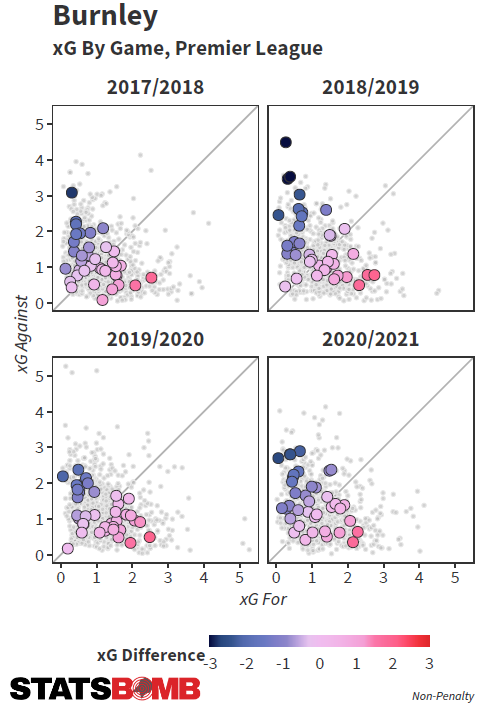 Hmm... Burnley are consistent. They have scored a similar average of points against the top seven as they have the rest of the league (0.7 to 0.8 per game). The problem here is it suggests that they are unlikely to suddenly launch themselves forward due to “easier” fixtures. And this similarity in rate has probably fed into the wider perception. In acquitting themselves adequately against better opposition, they've appeared better than they are. Sadly, these league low points numbers against the bottom thirteen are backed up by league low shot ratios and a league high deficit in conversion rate. It has been bad, it's still bad, it hasn't gone their way and they haven't shown they have enough to save themselves. Which is sad because they are a breath of fresh air and Sean Dyche is alright and... aargh, stop, stop, STOP! Sorry, Burnley, it's a tough old league. QPR General narrative/reality: “Harry left them in the shit and in the shit is where they remain.” Fixtures: Two away games against top seven sides that they will definitely lose, two matches against holidaying teams and a six pointer against Leicester. Home to West Ham and Newcastle are about as kindly a two fixtures as you could ask for right now and that's a good thing because they'll do well to get any other points. Their record against the top seven is awful, they average minus 3.1 shots on target per game against them which is as dismal as you might expect. They also have achieved fewer points than any other team against them: one, from a draw at home to Man City. They will surely get nothing from the return trip to City and another to Liverpool. In their favour, against the bottom 13 teams, they are a recognizably par outfit. Their shot ratios are at 50% (TSR) and 48% (SoTR), it is just that they've had a hard time converting that into points, their average against this group is only 1.2 per game. Compare this to Swansea who have a similar shot profile yet are picking up 1.7 points per game here and suddenly they look a little unfortunate. Having played a game more than the teams above, they will need to hope for sleepy old West Ham and Newcastle to roll over and take a trip to Leicester with something to play for. It's tough, they may not have sufficient fixtures to surpass others but their home form and record against lesser teams gives them slight hope. Leicester General narrative: “Not good enough, long since relegated” Reality: Woke up, smelt coffee, got some points. Fixtures: Two top seven sides, one holidaying team and three six pointers. Are Leicester one of the three worst teams in the league? Probably not:
Hmm... Burnley are consistent. They have scored a similar average of points against the top seven as they have the rest of the league (0.7 to 0.8 per game). The problem here is it suggests that they are unlikely to suddenly launch themselves forward due to “easier” fixtures. And this similarity in rate has probably fed into the wider perception. In acquitting themselves adequately against better opposition, they've appeared better than they are. Sadly, these league low points numbers against the bottom thirteen are backed up by league low shot ratios and a league high deficit in conversion rate. It has been bad, it's still bad, it hasn't gone their way and they haven't shown they have enough to save themselves. Which is sad because they are a breath of fresh air and Sean Dyche is alright and... aargh, stop, stop, STOP! Sorry, Burnley, it's a tough old league. QPR General narrative/reality: “Harry left them in the shit and in the shit is where they remain.” Fixtures: Two away games against top seven sides that they will definitely lose, two matches against holidaying teams and a six pointer against Leicester. Home to West Ham and Newcastle are about as kindly a two fixtures as you could ask for right now and that's a good thing because they'll do well to get any other points. Their record against the top seven is awful, they average minus 3.1 shots on target per game against them which is as dismal as you might expect. They also have achieved fewer points than any other team against them: one, from a draw at home to Man City. They will surely get nothing from the return trip to City and another to Liverpool. In their favour, against the bottom 13 teams, they are a recognizably par outfit. Their shot ratios are at 50% (TSR) and 48% (SoTR), it is just that they've had a hard time converting that into points, their average against this group is only 1.2 per game. Compare this to Swansea who have a similar shot profile yet are picking up 1.7 points per game here and suddenly they look a little unfortunate. Having played a game more than the teams above, they will need to hope for sleepy old West Ham and Newcastle to roll over and take a trip to Leicester with something to play for. It's tough, they may not have sufficient fixtures to surpass others but their home form and record against lesser teams gives them slight hope. Leicester General narrative: “Not good enough, long since relegated” Reality: Woke up, smelt coffee, got some points. Fixtures: Two top seven sides, one holidaying team and three six pointers. Are Leicester one of the three worst teams in the league? Probably not:  There we have a variety of simple measures and we see Leicester are quite bad but not terminally so. They have sprouted into life buoyed by four consecutive games of out-shooting their opponents, which they've turned into three wins. The fixture list is mildly encouraging too given that they have six games, three will be defining and one is the ever-tempting “home to Newcastle”. Their record against the top seven is pretty bad (running theme here...) in fact only QPR and Hull are worse, but has been fuelled by a poor save percentage (60%) and of fixtures against the top seven, a home tie against Southampton is perhaps least daunting. In fact their chances of survival are less about the capabilities of themselves, moreso the possible inabilities of their rivals. The improved form they have shown over the last month has raised their underlying numbers to a level that relegation could even be described as undeserved. Whilst they are far from safe, it is straightforward to understand why the bookmakers are seeing their survival as more likely than the next two teams to discuss. Hull City General Perception: “Someone tell Steve Bruce it isn't the referee's fault.” Reality: It isn't the referee's fault. Hull have just been bad. Fixtures: Four top seven teams, a trip to Pardew's Wonderland and a six pointer against Burnley. A touch of creative thinking is required to see Hull storming up the table. Newcastle are not a team that will visit soon, primarily because they came to Hull at the end of January and recorded one of only two league victories of 2015 and won 3-0. Ouch. Hull's general problems are not that they are consistently bad in matches against their peers, they are broadly adequate here, it is that they have so few matches left against them.
There we have a variety of simple measures and we see Leicester are quite bad but not terminally so. They have sprouted into life buoyed by four consecutive games of out-shooting their opponents, which they've turned into three wins. The fixture list is mildly encouraging too given that they have six games, three will be defining and one is the ever-tempting “home to Newcastle”. Their record against the top seven is pretty bad (running theme here...) in fact only QPR and Hull are worse, but has been fuelled by a poor save percentage (60%) and of fixtures against the top seven, a home tie against Southampton is perhaps least daunting. In fact their chances of survival are less about the capabilities of themselves, moreso the possible inabilities of their rivals. The improved form they have shown over the last month has raised their underlying numbers to a level that relegation could even be described as undeserved. Whilst they are far from safe, it is straightforward to understand why the bookmakers are seeing their survival as more likely than the next two teams to discuss. Hull City General Perception: “Someone tell Steve Bruce it isn't the referee's fault.” Reality: It isn't the referee's fault. Hull have just been bad. Fixtures: Four top seven teams, a trip to Pardew's Wonderland and a six pointer against Burnley. A touch of creative thinking is required to see Hull storming up the table. Newcastle are not a team that will visit soon, primarily because they came to Hull at the end of January and recorded one of only two league victories of 2015 and won 3-0. Ouch. Hull's general problems are not that they are consistently bad in matches against their peers, they are broadly adequate here, it is that they have so few matches left against them.
- Their record against the top seven is awful, and four matches remain against such teams: teams they have failed to beat all year.
- They have managed under a goal a game against the top seven whilst conceding an average of two.
- They create very few shots (c. 9 per game) whilst conceding a high volume (c. 15).
- They have less of the ball than any other team here (36%)
- On all the “semi-lucky” measures, they've haven't even had semi-luck: 59% save rate, bad conversion for (9%), bad conversion against (13%).
Being Hull right now isn't an attractive proposition but for all their faults, they are sitting on the shoulder of the team I feel is the worst in the league: Sunderland General Perception: “This happens every year” Reality: It does Fixtures: Three games against top seven teams plus away games at Stoke and Everton and crunch time versus Leicester. As mentioned earlier, last year, in similar circumstances to now, I bade farewell to Sunderland:  ...and they promptly turned water into wine and proceeded to toast themselves back into the Premier League for another season. So, could it happen again? Technically, yes. In reality, I am happy to write them off once more. Their top seven match-ups have provided league worst or tied worst numbers in a variety of shot and goal metrics, truly awful numbers, and they've three games against them to come:
...and they promptly turned water into wine and proceeded to toast themselves back into the Premier League for another season. So, could it happen again? Technically, yes. In reality, I am happy to write them off once more. Their top seven match-ups have provided league worst or tied worst numbers in a variety of shot and goal metrics, truly awful numbers, and they've three games against them to come: 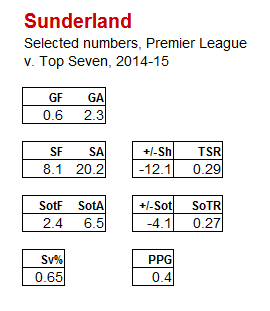 They are conceding so many shots and shots on target in these fixtures that they are effectively all but guaranteeing that they will not win. A sub-30% pair of shot ratios is the stuff of nightmares. Their save percentage here, whilst not in itself terrible, is sub-par. They have only managed to beat Palace, Stoke, Newcastle twice and Burnley this year and look to have very little chance of gaining positive results from most of their forthcoming matches. The 1-4 defeat against Palace, coming so quickly after the 0-4 Villa loss was as indicative of a team on the precipice as you're likely to see. Is there any hope in the numbers against the bottom 13? Not a lot. They are really grindy, don't take very many shots, which doesn't translate into many goals or points. Ironically here, it is their save percentage that is helping them by running extremely high at 76%. This alone can be credited as the reason for which they haven't lost as many games as you could reasonably expect and why despite a season of unsuccessful football, they still remain outside the bottom three. It can't remain that way, can it? Final thoughts I'm being kind and giving Sherwood fuelled Villa a free pass here, maybe that's too kind given tricky fixtures but as I explored last week, they've become a very different team under his tenure; their numbers are now largely par. Newcastle are a different story, a team who appear to have mastered the trick of getting just enough points before calling stumps; they've likely done all they need or will. Pulis has hauled West Brom clear and so we're left with the five teams discussed. I believe that if Sunderland survive once more, they will be probably the worst team to have stayed up since, well, last year's Sunderland team. So much of their season has has been represented by dour, unenlightening play, one can easily be drawn to the pluck of Leicester or the frivolity of QPR as preferred ingredients for next year's league soup. Nor would I particularly miss Hull's brand of football. They have improved slightly over time but have spent large swathes of the season posting inadequate numbers and if either of these two survives, as seems quite likely, major remedial work will be needed on their squads going forward. The potential is lacking for now and the league will not stand still. But who goes down? The bookies say QPR and Burnley are all but gone and one of Hull or Sunderland but in truth none of these teams will finish the season with any solid claims for retaining their place. One of these managers is going to find himself sitting in his office at about 6pm on the 24th of May, disheveled and weary, unable to believe his luck. And luck will likely contribute. With so few games to play, these teams need to catch a couple of breaks and as we saw with Sunderland's Lazarus turn last year, relegation is never certain until the trap door opens. ~~~~~~~~~~~~~~~~~~~~~~~~~~~~~~~~~~~~~~ Thanks for reading! Find me on Twitter here: @jair1970
They are conceding so many shots and shots on target in these fixtures that they are effectively all but guaranteeing that they will not win. A sub-30% pair of shot ratios is the stuff of nightmares. Their save percentage here, whilst not in itself terrible, is sub-par. They have only managed to beat Palace, Stoke, Newcastle twice and Burnley this year and look to have very little chance of gaining positive results from most of their forthcoming matches. The 1-4 defeat against Palace, coming so quickly after the 0-4 Villa loss was as indicative of a team on the precipice as you're likely to see. Is there any hope in the numbers against the bottom 13? Not a lot. They are really grindy, don't take very many shots, which doesn't translate into many goals or points. Ironically here, it is their save percentage that is helping them by running extremely high at 76%. This alone can be credited as the reason for which they haven't lost as many games as you could reasonably expect and why despite a season of unsuccessful football, they still remain outside the bottom three. It can't remain that way, can it? Final thoughts I'm being kind and giving Sherwood fuelled Villa a free pass here, maybe that's too kind given tricky fixtures but as I explored last week, they've become a very different team under his tenure; their numbers are now largely par. Newcastle are a different story, a team who appear to have mastered the trick of getting just enough points before calling stumps; they've likely done all they need or will. Pulis has hauled West Brom clear and so we're left with the five teams discussed. I believe that if Sunderland survive once more, they will be probably the worst team to have stayed up since, well, last year's Sunderland team. So much of their season has has been represented by dour, unenlightening play, one can easily be drawn to the pluck of Leicester or the frivolity of QPR as preferred ingredients for next year's league soup. Nor would I particularly miss Hull's brand of football. They have improved slightly over time but have spent large swathes of the season posting inadequate numbers and if either of these two survives, as seems quite likely, major remedial work will be needed on their squads going forward. The potential is lacking for now and the league will not stand still. But who goes down? The bookies say QPR and Burnley are all but gone and one of Hull or Sunderland but in truth none of these teams will finish the season with any solid claims for retaining their place. One of these managers is going to find himself sitting in his office at about 6pm on the 24th of May, disheveled and weary, unable to believe his luck. And luck will likely contribute. With so few games to play, these teams need to catch a couple of breaks and as we saw with Sunderland's Lazarus turn last year, relegation is never certain until the trap door opens. ~~~~~~~~~~~~~~~~~~~~~~~~~~~~~~~~~~~~~~ Thanks for reading! Find me on Twitter here: @jair1970
Tim Sherwood: The Secrets Of Success And This Week's Other EPL Stat Stories
I had been champing at the bit to write about Tim Sherwood but after this last weekend, it feels a little more like a necessary procedure akin to having root canal treatment. Damn it though I'm an analyst, to some at least, and come hell or high water one must continue. Sherwood, despite widespread unpopularity amongst Tottenham fans dismissive of his win percentage, showed humility and decency in his special one-on-one Match of the Day interview. With a glint in his eye joined merrily by the tiniest yet most obvious smirk he may well have provoked a little ire but he brings a certain appeal that if not quite box office is certainly worthy of soap opera. He has returned to our lives in the guise of Aston Villa manager and has quickly posted a 37% win percentage- an instant improvement on the 20% Paul Lambert accrued thanks to an aversion to creativity and goalscoring. He's back, he's got his striker scoring again and as such Goal of the Month competitions have resumed at Villa Park, but what's under the hood for our Tim? 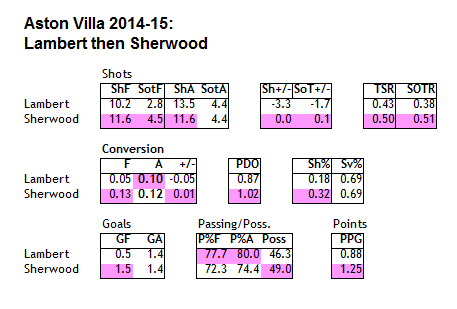 Firstly, Lambert presided over one of the most miserable Premier League seasons in recent memory. A sub-five percent conversion rate meant that a proverbial grandmother could have come in and improved the situation. An ideal gig for a confident and confidence-orientated manager? For sure. The most relevant thing about Villa under Sherwood to me is that their shooting numbers are solidly par. They are a roughly 50% team under his tutelage and it holds across a variety of other numbers including possession (49%), Finishing/PDO (1.02), total conversion (+0.01) and even goals for / against (1.5:1.4). How he is generating these numbers is interesting given that as a Tottenham fan, I have some insight as to how Tim Sherwood sets up his teams and how he attempts to generate results. And in this early analysis, there are some notable similarities to his Tottenham tenure. Samples are small, twenty-two games and eight but already we can pull specific likenesses:
Firstly, Lambert presided over one of the most miserable Premier League seasons in recent memory. A sub-five percent conversion rate meant that a proverbial grandmother could have come in and improved the situation. An ideal gig for a confident and confidence-orientated manager? For sure. The most relevant thing about Villa under Sherwood to me is that their shooting numbers are solidly par. They are a roughly 50% team under his tutelage and it holds across a variety of other numbers including possession (49%), Finishing/PDO (1.02), total conversion (+0.01) and even goals for / against (1.5:1.4). How he is generating these numbers is interesting given that as a Tottenham fan, I have some insight as to how Tim Sherwood sets up his teams and how he attempts to generate results. And in this early analysis, there are some notable similarities to his Tottenham tenure. Samples are small, twenty-two games and eight but already we can pull specific likenesses: 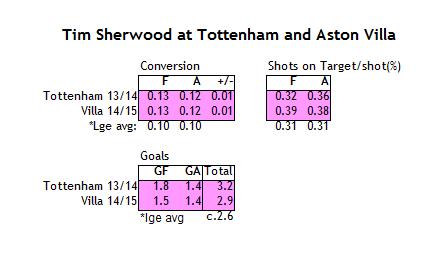 A few choice numbers there but revealing, in particular when held up against league averages as shown. Each of these statistics I feel are a reasonable proxy for how Tim Sherwood sets up his teams and the way he approaches football matches. We can see that in both his jobs the conversion rates for and against have been high, the rate of shots created and allowed that are on target is extremely high and the goal totals in games have clearly exceeded league averages. To those of us who watched the back end of Tottenham's 2013-14 season, none of these points will come as a surprise. Sherwood regularly entrusted 19 year old Nabil Bentaleb to a nominal defensive midfield role. Alone. Meanwhile five more attack minded players endeavoured to wreak havoc ahead. Some of these set-ups appeared naïve, or even ill conceived, and they provided mixed results. So much so that when combined with an over willingness to share in the media, his departure was not mourned widely. Sherwood's methods appeared to sacrifice control at the altar of chance and his gung ho attitude was too nerve-wracking for supporters more recently acquainted with the prescriptive stylings of Villas Boas. He has found a similar scenario at Villa and seemingly approached it the same way. Paul Lambert's latter period was characterised by some extremely cautious, even negative, ball retention and Villa often played as if they feared losing. This is no longer the case. The reality of a 3-3 draw at home to QPR as Redknapp protégés slug things out shows where the football has headed for Villa. And weirdly, this might not be a bad thing. Whereas Sherwood's methods ultimately fell short of requirements at Tottenham, they could well be exactly what is needed for a club battling relegation. “You win some, you lose some” is a hell of a strong maxim for a team that hasn't been winning many at all and deserved to win fewer. His current early record of 3-1-4 will do them just fine if maintained and suggests that “having a go” is at least, a short term fix. It isn't particularly technical, it might end in tears but Sherwood's magic is simple: pump up your chest, glue your heart to your sleeve and get out there and play like you're worth it. So welcome back, Tim. Stat Shorts 1. Chelsea are limping but what does it matter? Since trouncing Swansea 5-0, Chelsea's form has been decidedly less impressive. It will likely mean nothing as Arsenal and Man Utd have taken too long to flourish but with little impact from score effects, to have been outshot by a combined 52(17) to 29(7) in their last three away games against West Ham, Hull and QPR is head-scratchingly non-creditworthy. Taking all nine points from those fixtures means “who cares?” and the trophy engraving has likely been scheduled. 2. Newcastle are phoning it in It happened last year, it's happening again: Christmas lasts four or five months in Newcastle as regular donations of three points are handed out to all and sundry. I mean, they lost to Sunderland last week and that's a team i'm sorely tempted to bestow with a “least deserving” award, so bad they've been. Competition winner John Carver has had a tough run of fixtures and has been scalded by a horrible opposition conversion rate: Newcastle are conceding 16% of shots faced compared to scoring 8% of their own. This can't last forever but we saw the same utterly banal form the same time last year and a repeat was foretold by one of our sage analysts back at the end of January: https://twitter.com/colinttrainor/status/561450632557891584 @Objectivefooty has also come up with a novel solution: https://twitter.com/ObjectiveFooty/status/587749219710193664 Maybe I'm being harsh? In isolation I'd agree but Newcastle are coasting once more and the blueprint does not include this kind of form early season, a potential situation which will surely require remedy over the summer. Won't it? 3. Pulisball wobbles We know Pulis puts up sub-par numbers. We know Pulis has defined inflexible methods that tend towards overachieving against them. What we don't know is what's going wrong at West Brom that has led his team to concede seven goals in two games against Leicester and QPR. He's still picked up points at the same rate as Sherwood (1.25 a game) but what he hasn't got coming any time soon is fixtures as nominally winnable as those last two. They may be able to beat Newcastle, but beyond that none of their remaining fixtures look winnable and one wonders just how much psychological damage was inflicted by a frenzied Man City that day. That's not stats, I hear you cry, and I know so here's a chart:
A few choice numbers there but revealing, in particular when held up against league averages as shown. Each of these statistics I feel are a reasonable proxy for how Tim Sherwood sets up his teams and the way he approaches football matches. We can see that in both his jobs the conversion rates for and against have been high, the rate of shots created and allowed that are on target is extremely high and the goal totals in games have clearly exceeded league averages. To those of us who watched the back end of Tottenham's 2013-14 season, none of these points will come as a surprise. Sherwood regularly entrusted 19 year old Nabil Bentaleb to a nominal defensive midfield role. Alone. Meanwhile five more attack minded players endeavoured to wreak havoc ahead. Some of these set-ups appeared naïve, or even ill conceived, and they provided mixed results. So much so that when combined with an over willingness to share in the media, his departure was not mourned widely. Sherwood's methods appeared to sacrifice control at the altar of chance and his gung ho attitude was too nerve-wracking for supporters more recently acquainted with the prescriptive stylings of Villas Boas. He has found a similar scenario at Villa and seemingly approached it the same way. Paul Lambert's latter period was characterised by some extremely cautious, even negative, ball retention and Villa often played as if they feared losing. This is no longer the case. The reality of a 3-3 draw at home to QPR as Redknapp protégés slug things out shows where the football has headed for Villa. And weirdly, this might not be a bad thing. Whereas Sherwood's methods ultimately fell short of requirements at Tottenham, they could well be exactly what is needed for a club battling relegation. “You win some, you lose some” is a hell of a strong maxim for a team that hasn't been winning many at all and deserved to win fewer. His current early record of 3-1-4 will do them just fine if maintained and suggests that “having a go” is at least, a short term fix. It isn't particularly technical, it might end in tears but Sherwood's magic is simple: pump up your chest, glue your heart to your sleeve and get out there and play like you're worth it. So welcome back, Tim. Stat Shorts 1. Chelsea are limping but what does it matter? Since trouncing Swansea 5-0, Chelsea's form has been decidedly less impressive. It will likely mean nothing as Arsenal and Man Utd have taken too long to flourish but with little impact from score effects, to have been outshot by a combined 52(17) to 29(7) in their last three away games against West Ham, Hull and QPR is head-scratchingly non-creditworthy. Taking all nine points from those fixtures means “who cares?” and the trophy engraving has likely been scheduled. 2. Newcastle are phoning it in It happened last year, it's happening again: Christmas lasts four or five months in Newcastle as regular donations of three points are handed out to all and sundry. I mean, they lost to Sunderland last week and that's a team i'm sorely tempted to bestow with a “least deserving” award, so bad they've been. Competition winner John Carver has had a tough run of fixtures and has been scalded by a horrible opposition conversion rate: Newcastle are conceding 16% of shots faced compared to scoring 8% of their own. This can't last forever but we saw the same utterly banal form the same time last year and a repeat was foretold by one of our sage analysts back at the end of January: https://twitter.com/colinttrainor/status/561450632557891584 @Objectivefooty has also come up with a novel solution: https://twitter.com/ObjectiveFooty/status/587749219710193664 Maybe I'm being harsh? In isolation I'd agree but Newcastle are coasting once more and the blueprint does not include this kind of form early season, a potential situation which will surely require remedy over the summer. Won't it? 3. Pulisball wobbles We know Pulis puts up sub-par numbers. We know Pulis has defined inflexible methods that tend towards overachieving against them. What we don't know is what's going wrong at West Brom that has led his team to concede seven goals in two games against Leicester and QPR. He's still picked up points at the same rate as Sherwood (1.25 a game) but what he hasn't got coming any time soon is fixtures as nominally winnable as those last two. They may be able to beat Newcastle, but beyond that none of their remaining fixtures look winnable and one wonders just how much psychological damage was inflicted by a frenzied Man City that day. That's not stats, I hear you cry, and I know so here's a chart: 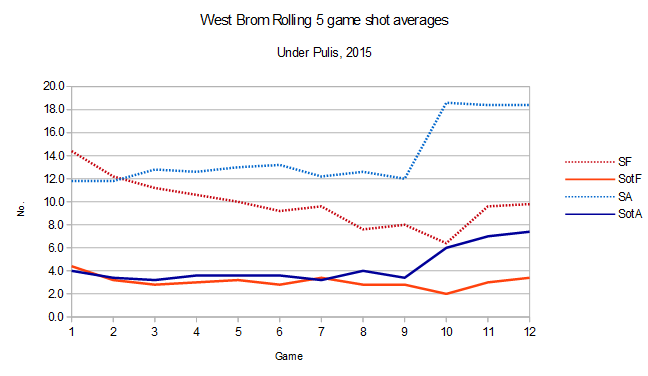 Sure, the City game ruined this, but it was heading for the rubbish tip anyway. Tough times at the Hawthorns. Obligatory Tottenham Exhaustion “You see, them lads down at Tottenham are young. And they've played a lot of games and worked hard all season. Lots of training, lots of games and now they're knackered. And it shows. Danny Rose is their best player at the moment, Danny Rose! Their attack has given up and even the fans are questioning Pochettino. Is he up to the job? Well? Is he? We just don't know. He keeps picking the wrong players. Week by week players disappear then return magically for a game or two then get dropped. Fazio rose from the ashes this week and got blamed for the goal. But he's barely played in weeks. Paulinho gets slated every time he gets near the pitch but he's not match fit. It's a nightmare. Half the team are gonna get shipped on in the summer and a few of the rest probably aren't up to it. You could drive a train through our defence at times, so easy is it for the opposition! At least we've got Villa at home this weekend though, be good to turn over Sherwood. Last thing we need to see is his grinning mug...” ~~~~~~~~~~~~~~~~~~~~~~~~~~~~~~~~~~~~~~~~~~~~~~~~ Thanks for reading! Find me on twitter here: @jair1970
Sure, the City game ruined this, but it was heading for the rubbish tip anyway. Tough times at the Hawthorns. Obligatory Tottenham Exhaustion “You see, them lads down at Tottenham are young. And they've played a lot of games and worked hard all season. Lots of training, lots of games and now they're knackered. And it shows. Danny Rose is their best player at the moment, Danny Rose! Their attack has given up and even the fans are questioning Pochettino. Is he up to the job? Well? Is he? We just don't know. He keeps picking the wrong players. Week by week players disappear then return magically for a game or two then get dropped. Fazio rose from the ashes this week and got blamed for the goal. But he's barely played in weeks. Paulinho gets slated every time he gets near the pitch but he's not match fit. It's a nightmare. Half the team are gonna get shipped on in the summer and a few of the rest probably aren't up to it. You could drive a train through our defence at times, so easy is it for the opposition! At least we've got Villa at home this weekend though, be good to turn over Sherwood. Last thing we need to see is his grinning mug...” ~~~~~~~~~~~~~~~~~~~~~~~~~~~~~~~~~~~~~~~~~~~~~~~~ Thanks for reading! Find me on twitter here: @jair1970
Top 6 Teams in the Premier League (by xG)
As was the case last time, these are offensive and defensive efficiency rankings for the Premier League teams. I’m defining offensive efficiency as xG created, divided by number of games played. So for example, if Man United created 10 xG in 5 games, its offensive efficiency would be 2.0 xG per game. Defensive efficiency is similar, but uses xG conceded instead of xG created. I’ve posted the big xG chart that ranks all the Premier League teams at the bottom, but for today, I’d like to focus on the best six teams of season so far. Thanks again to Michael Caley for providing me data from his ExpG model. So there you go. If you have any questions about my definitions or other things, please feel free to hit me up in the comments section. 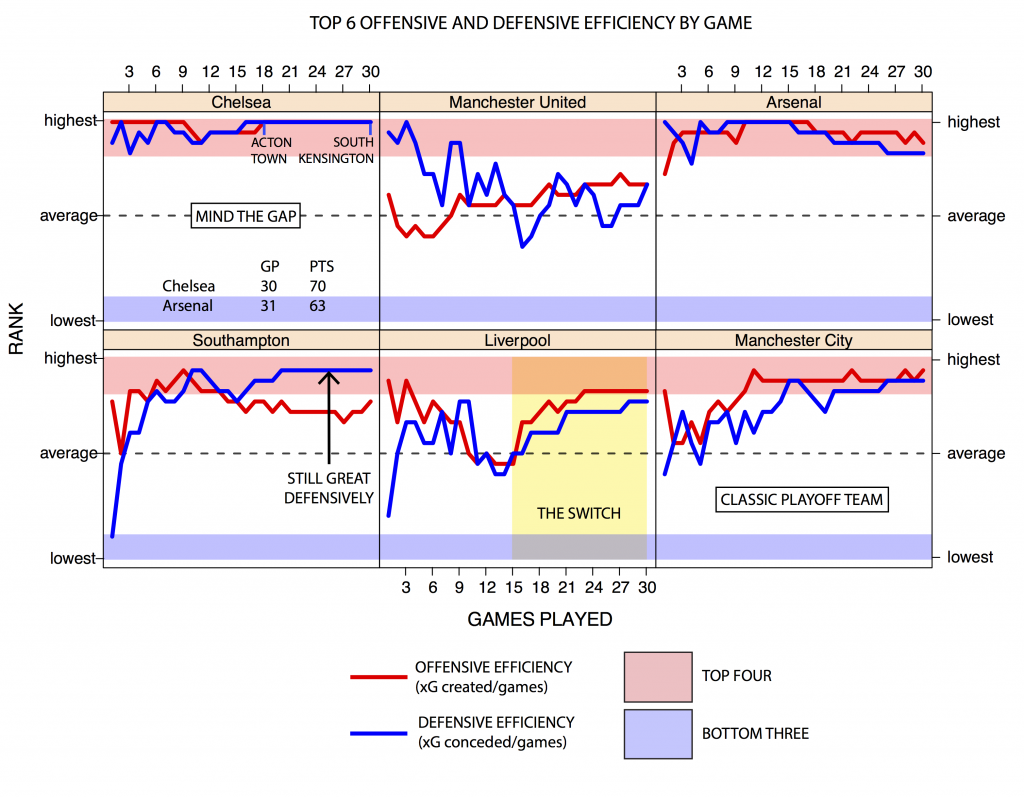 Green Shoots Losses to Arsenal and Man United may have slowed Liverpool’s roll, but Brendan Rodgers’ side has re-established itself as a serious force after a sticky start to post-Suarez life. As has been well documented, Brendan Rodgers made a tactical switch mid-season by shifting the creative burden to Philippe Coutinho in a playmaking role behind the striker. I’ll leave the curation of a more detailed narrative to Michaels Caley and Cox, but since Coutinho’s Arrival (yes, capital ‘A’), the Reds’ offense has developed into the shifting, cutting monster that we all hoped was still possible after the Suarez transfer. Liverpool has gone from a middle of the pack offensive efficiency of 1.22 ExpG/game, to a dazzling 1.69 ExpG/game, which comes in just below Chelsea’s league-best mark. You can cut that with all the qualifiers you want, but allow me one of my own - that’s without a fully fit Daniel Sturridge, who was one of the 10 best players in the league last season. The efficiency chart also shows that Liverpool have improved defensively since ‘The Switch”. The change isn’t quite as dramatic as what happened on the offensive end, but the Reds have squirmed their way to respectability. At 1.06 xG conceded/game, they are the midpoint between elite and league average. It will be interesting to see whether Fenway Sports Group (FSG) will delve into the transfer market to bring in some more talent on the defensive end. Lucas is good, but struggles with injuries each season. Emre Can is a talented footballer who has played well at
Green Shoots Losses to Arsenal and Man United may have slowed Liverpool’s roll, but Brendan Rodgers’ side has re-established itself as a serious force after a sticky start to post-Suarez life. As has been well documented, Brendan Rodgers made a tactical switch mid-season by shifting the creative burden to Philippe Coutinho in a playmaking role behind the striker. I’ll leave the curation of a more detailed narrative to Michaels Caley and Cox, but since Coutinho’s Arrival (yes, capital ‘A’), the Reds’ offense has developed into the shifting, cutting monster that we all hoped was still possible after the Suarez transfer. Liverpool has gone from a middle of the pack offensive efficiency of 1.22 ExpG/game, to a dazzling 1.69 ExpG/game, which comes in just below Chelsea’s league-best mark. You can cut that with all the qualifiers you want, but allow me one of my own - that’s without a fully fit Daniel Sturridge, who was one of the 10 best players in the league last season. The efficiency chart also shows that Liverpool have improved defensively since ‘The Switch”. The change isn’t quite as dramatic as what happened on the offensive end, but the Reds have squirmed their way to respectability. At 1.06 xG conceded/game, they are the midpoint between elite and league average. It will be interesting to see whether Fenway Sports Group (FSG) will delve into the transfer market to bring in some more talent on the defensive end. Lucas is good, but struggles with injuries each season. Emre Can is a talented footballer who has played well at left right back, but he got found out against Man United and might be better suited to a midfield role in the long term. There’s work to do, but this team is young, solid on both sides of the ball and has plenty of room to improve. It took a while, but this team has adjusted to life without Suarez and the future looks a lot rosier than it did even a few months ago. That’s why all this Sterling contract stuff sounds like hot air. FSG may have played hardball with Manny Ramirez back in the day, but this isn’t baseball. Football is just different, it’s a team sport and losing your most important player, which is what Raheem Sterling has become for Liverpool, will affect every facet of your team’s play. John Henry has recent, firsthand experience of what that’s like. This season’s reboot cost Liverpool Stevie G’s last chance at a title, Champion’s League qualification and years of Brendan Rodgers’ life! Why oh why would Henry have any interest in doing the same thing next season? King Louis It’s news to no one but your auntie, that Louis van Gaal and Ronald Koeman don’t like each other. This season, Koeman had the chance to deliver a body blow to his fellow Dutchman’s career, but he appears to have missed his opportunity. Think about it for a second. Last summer, van Gaal steered an unfancied Dutch team deep into the World Cup knockout stages. It was great news for the Oranje, but terrible news for the Red Devils, since it meant that Van Gaal took charge at the tail end of the preparation stages for the new season. He inherited a team that wasn’t so much ‘broken’ as not yet constructed. If you imagine Jose Mourinho starting this season at the head of a mutant crew sailing the Black Pearl, then spare a thought for Van Gaal who turned up at the docks ready to set sail, only to find a feverish Ed Woodward pointing excitedly at a bathtub filled with stacks of marginally different, mahogany Captains’ Wheels. By the time King Louis realized what he was working with, the only players available were overpriced and didn’t really fit into the scheme he intended on implementing. So he bought them anyway. For almost the entire season, Southampton has been a better team than Man United. The Saints pair elite defensive efficiency (0.96 xG conceded/game) with above average offensive performance (1.46 xG created/game). That’s good for an xG differential of 0.50 xG/game (1.46 – 0.96), or more than double Man United’s current xG differential of 0.21 xG/game. What we’ve seen unfold over the course this Man United season wasn’t a coaching masterclass, but a testament to the value of top class strikers and goalkeepers. Overtraining led to an injury crisis of biblical proportions and inflexible tactics meant long spells on the bench for some of the team’s most talented players. All season, Van Gaal’s team has been little more than above average on both sides of the ball. Yet with 7 games left, Man United sit comfortably among the Champion’s League places thanks to a sky high PDO (still the highest in the league according to @ObjectiveFooty’s ‘Main Table’). Despite the pedigree of some of their players, the Red Devils are rather Pulisian in the way they try to muck things up. Just like Pulis’ teams, they slow the game down; they don’t mind trading in attacking opportunities for solidity on the defensive end. This tactic works for Pulis, because his teams are usually underdogs. Slowing the pace down condenses the game, and a shorter game means a greater chance of a random outcome (e.g. that the lesser team gets a result). It works for Van Gaal because he’s willing to bet that in a game of few opportunities, his strikers and his goalkeeper will be more clinical in taking their chances than yours. And that is exactly what has happened. Wayne Rooney and Co. have scored 36.9% (again from @ObjectiveFooty) of their shots on target. That’s the best team scoring percentage in the league. Also best in the league is David de Gea’s 75.0% save rate. That’s impressive on it’s own, but things get really crazy when you look at where he’s saving shots from. 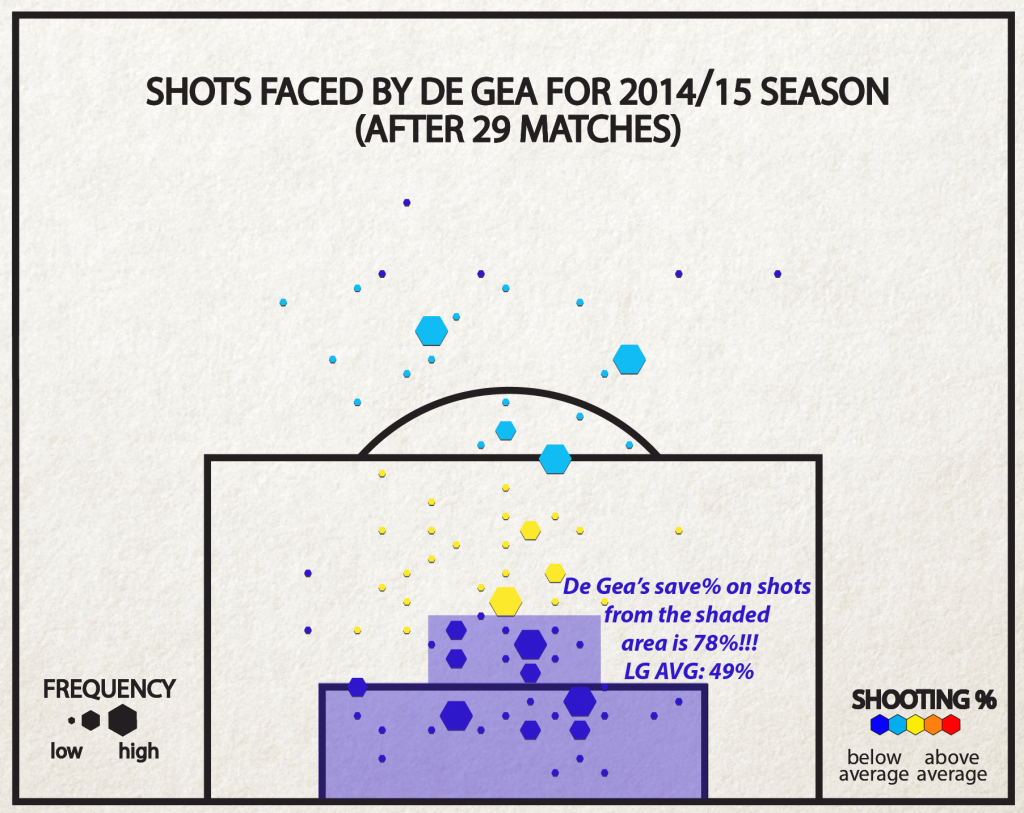 Shots on target from the shaded area are normally scored at a 51% clip, yet Man United’s opponents are converting these shots at a meager 22% (6 of 27). A league average keeper could reasonably be expected to concede 13 goals on that many shots from these areas – De Gea has conceded only 6. Clearly this is unsustainable; his save% from these areas close to goal is better than his save% from the other less dangerous areas. But it may not matter… Van Gaal’s men are 8 points clear of the chasing pack and look like a better side each passing week. This summer, King Louis will spend again, but this time, he’ll have time to pick his targets and an uncluttered offseason to mold his team’s identity. Had Southampton managed to clinch a Champions’ League spot, it might have been curtains for Van Gaal, as ownership grew skittish over the terms of team’s lucrative shirt sponsorship. Instead, it’s Koeman looking for answers ahead of Morgan Schneiderlein’s probable departure and, God forbid, the potential burden of Europa League qualification.
Shots on target from the shaded area are normally scored at a 51% clip, yet Man United’s opponents are converting these shots at a meager 22% (6 of 27). A league average keeper could reasonably be expected to concede 13 goals on that many shots from these areas – De Gea has conceded only 6. Clearly this is unsustainable; his save% from these areas close to goal is better than his save% from the other less dangerous areas. But it may not matter… Van Gaal’s men are 8 points clear of the chasing pack and look like a better side each passing week. This summer, King Louis will spend again, but this time, he’ll have time to pick his targets and an uncluttered offseason to mold his team’s identity. Had Southampton managed to clinch a Champions’ League spot, it might have been curtains for Van Gaal, as ownership grew skittish over the terms of team’s lucrative shirt sponsorship. Instead, it’s Koeman looking for answers ahead of Morgan Schneiderlein’s probable departure and, God forbid, the potential burden of Europa League qualification. 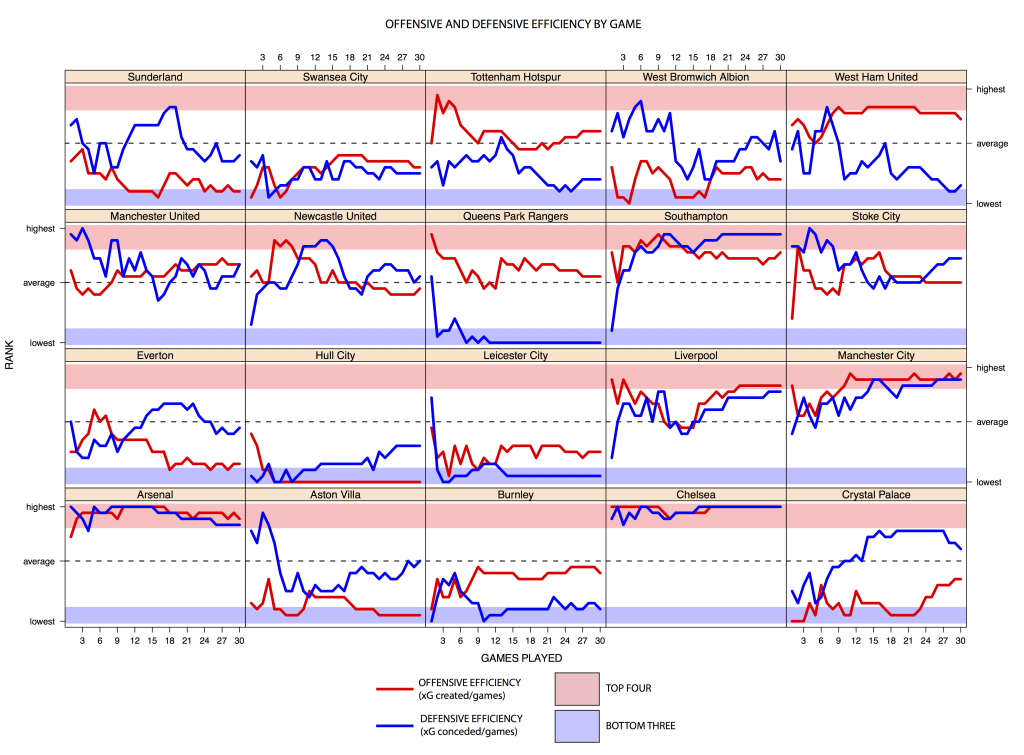
What Is Wrong With Daniel Sturridge?
I buy the Times on occasion (not for political reasons, or an endorsement of Rupert Murdoch's empire: I like some of the puzzles) and this Thursday there was an interesting small analysis piece on Daniel Sturridge written by Rory Smith. What drew my attention was the general intention of the article to depict Sturridge as being “short of confidence”. It went on to criticise Sturridge's efforts against Blackburn citing amongst other things “poor choices”, being “unsure of his instincts” (?) and that his “energy [was] wayward and incoherent.”(??). Nope, me neither.
He also “looked a shadow of the prolific goalscorer who terrorised defenses last season.” Okay, maybe he didn't have his best game? What else? “The less confidence Sturridge has, the more he seems to retreat into cockiness” and “[he] takes too many touches, slipping the ball under his feet, throwing dummies and feints, a desperate dance designed, perhaps [!], to convince him[self] of his own qualities.” This latter section is a knowingly counter-intuitive argument and one which surely doesn't hold firm. Even without getting into the stats (we will) Sturridge has never seemed a man needing a shot of confidence to effect positive endeavour.
What does Daniel Sturridge do?
I'm pretty happy to declare that Daniel Sturridge is two things:
1. An elite level striker
2. Injury prone
The elite level striker angle is easy to prove: his entire career he's consistently averaged four or five shots a game and mapping back even through his “kid learning the ropes” stages he averages over 0.6 goals per game. He's a pure striker, a darn good one and has always been so. More fool Chelsea for selling him when they did. But... His injury record stinks. He's been involved in professional football since a young age and has participated in seven seasons. He was back-up or a rotational player in the early years but still, the guy is 25 years old and has never played more than 2/3 of a season.
2014-15
So, a familiar storyline of injury and absence and he reaches mid-April with only 750 league minutes to his name. He “struggles to recapture top form” and has “only scored four goals since returning from several injuries.” This seems like a fair argument if you blindly consider four to be a small number but if we pull up some shot and goal numbers, we can see that perceived problems may well be smaller than is being suggested: 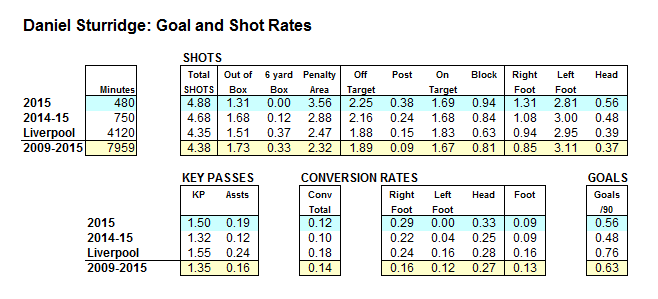 I've highlighted two sections particularly to make the point. With data stretching over nearly 8000 minutes from 2009 to 2015 we have as near as we can get to career rates and despite it being a small sample in 2015 (he has only played 480 league minutes since returning from many months injured) we can also take a look at what he's doing since coming back into the team. I have also put in this season's cumulative rate and his entire Liverpool career by way of contrast.
I've highlighted two sections particularly to make the point. With data stretching over nearly 8000 minutes from 2009 to 2015 we have as near as we can get to career rates and despite it being a small sample in 2015 (he has only played 480 league minutes since returning from many months injured) we can also take a look at what he's doing since coming back into the team. I have also put in this season's cumulative rate and his entire Liverpool career by way of contrast.
What can we see?
- His career shot rate is 4.38, his Liverpool rate is similar and he's recently above that level.
- Whilst he is lacking in recent six yard box activity (“poaching”) his rate of penalty area shots to out of box shots has increased over time, and is currently high.
- His on target rate is incredibly consistent across his whole career.
- He has always and continues to takes all kinds of shot at similar rates (left foot, right, header).
- His Key Pass rate is consistent throughout.
- His Liverpool conversion rate is very high overall but has dropped back this season. Multiple studies have shown that conversion rates have poor levels of repeatability so change here cannot be solely attributed to anything apart from random variation. He had been running extremely hot in this measure over the season and a half he'd been at Liverpool, much like Giroud, Costa or Kane are this season and a cooling off is not significant in itself.
- His goal rate is a fraction beneath his career rate and 0.20 goals per 90 below his very high overall Liverpool rate.
Alright so; shots wise, he's just dandy, goal-wise he's a little off. Well, again I can point to the small sample and suggest there is little cause for concern. Given the time he has been on the pitch, one or two more goals would have covered the conversion and goal per 90 deficits shown. That's it. If you are to posit that Daniel Sturridge is out of form or “short of confidence” then effectively you are suggesting that he has reached this negative mindset via the method of missing one or two goal scoring chances. And if I want to give Sturridge a break I really could. I can identify three simple factors which could have impacted on his production in 2015:
1. He is playing in an unfamiliar formation (3-4-3), adaptation could take time.
2. He has just returned from a series of injuries and so may need time to gain full match sharpness.
3. He is no longer playing alongside one of the most devastating attacking players in the world, the dervish-like Luis Suarez.
Despite these factors, his personal contribution to Liverpool when in the team is solid in relation to his career and once more consistent. I don't see self-concern in Daniel Sturridge's performances and I suspect that over time it will be seen that it was an extremely strange deduction to make. The answer to the question posed in the title is simple: if fit, not a lot. ~~~~~~~~~~~~~~~~~~~~~~~~~~~~
Thanks for reading!
Find me on Twitter: @jair1970
The Story Of Nil, Shot Dominance And A Premier League Weekend Review
When you attempt to write a statistical and analytics-based Premier League round-up column every week of the season, it can be somewhat dispiriting to see parts of the league meander towards an almost inevitable status quo. Nothing wrong with that per se, but finding interesting hooks to write about can become a tricky task. As such, this week we're going on a bit of a holiday and we have more of a quirky investigation than a news report. It's more a diet of "Louis Theroux" than "The One Show" and we should all feel better for it. Maybe. Hopefully. The Story of Nil As a plentiful supply of goals flew in, there wasn't a lot of “nil” around in the Premier League this weekend, at least until Sunday, and only four teams contributed: Southampton, Burnley, Tottenham and Newcastle. Of these four teams, the away teams offered particularly little in the way of healthy shot counts and as such widely deserved their “nil”:  The international break, whilst generally dismal from a fan perspective, does at least offer time to ponder questions and explore data. This being so, I've been able to explore a few mini-topics that have intrigued me, one of which is the superficially nonsensical question: “How many shots does it take to score nil?” So using data I lovingly collected over many, many hours then ignored for a couple of months I can tell you that in the Premier League between 2009-10 and 2013-14, there were 1050 instances of a team scoring nil. And I can produce this table of averages:
The international break, whilst generally dismal from a fan perspective, does at least offer time to ponder questions and explore data. This being so, I've been able to explore a few mini-topics that have intrigued me, one of which is the superficially nonsensical question: “How many shots does it take to score nil?” So using data I lovingly collected over many, many hours then ignored for a couple of months I can tell you that in the Premier League between 2009-10 and 2013-14, there were 1050 instances of a team scoring nil. And I can produce this table of averages: 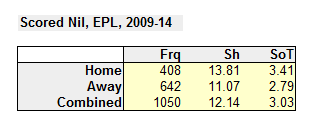 Well, well! Our table of averages matches very well with this weekend's nil scorers! Pure chance, I assure you. Over the duration of the sample, goals are scored from around ten percent of all shots and 30 percent of all shots on target. As we're looking at nil, the shot on target figure correlates nicely, on average somewhere between every third and fourth recorded shot on target becomes a goal and average nil scorers do not exceed this range. In fact, the “nil” scorer has a problem with its shot on target rate, it averages out at around 25 percent, five percent shy of the average for all. Another aspect we can see here is a difference in the location of the “nil” between home and away. A bias towards home advantage is clear in frequency (408 to 642) and in the volume of shots recorded. Despite achieving the same final outcome, “nil”, home teams recorded an average of 2.74 more shots and 0.62 shots on target than the away team. This is something we can also see in this next section. So: how many shots does it take to score nil? About 12, with three on target. Shot Dominance I'm defining "shot dominance" as the difference in the volume of shots a team has in contrast to its opposition. A simple frequency chart using the same data as before, produces a familiar shaped graph:
Well, well! Our table of averages matches very well with this weekend's nil scorers! Pure chance, I assure you. Over the duration of the sample, goals are scored from around ten percent of all shots and 30 percent of all shots on target. As we're looking at nil, the shot on target figure correlates nicely, on average somewhere between every third and fourth recorded shot on target becomes a goal and average nil scorers do not exceed this range. In fact, the “nil” scorer has a problem with its shot on target rate, it averages out at around 25 percent, five percent shy of the average for all. Another aspect we can see here is a difference in the location of the “nil” between home and away. A bias towards home advantage is clear in frequency (408 to 642) and in the volume of shots recorded. Despite achieving the same final outcome, “nil”, home teams recorded an average of 2.74 more shots and 0.62 shots on target than the away team. This is something we can also see in this next section. So: how many shots does it take to score nil? About 12, with three on target. Shot Dominance I'm defining "shot dominance" as the difference in the volume of shots a team has in contrast to its opposition. A simple frequency chart using the same data as before, produces a familiar shaped graph: 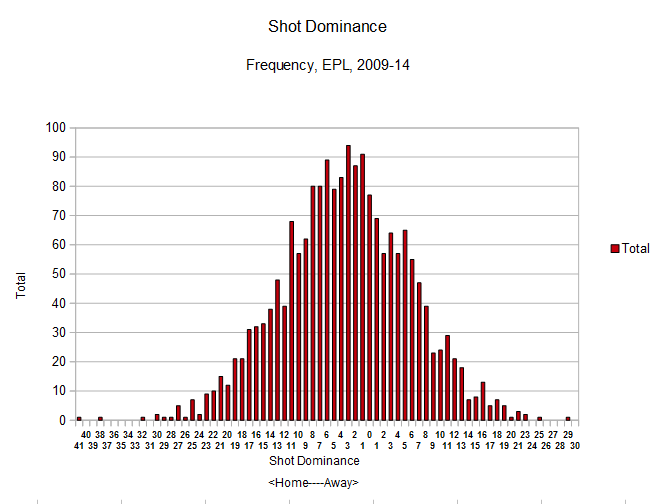 This shows a huge majority of Premier League matches involve a shot differential of under ten, which is logical when tallying with a long-term average of around twenty eight shots per game (although a trend for this season would bring it lower). I've had ideas around this on the back burner for a little while now but was spurred into trying to make coherent sense of the data by a tweet highlighting some of @JamesWGrayson's work from @WillTGM and an observation Statsbomb's Colin Trainor made in the replies:
This shows a huge majority of Premier League matches involve a shot differential of under ten, which is logical when tallying with a long-term average of around twenty eight shots per game (although a trend for this season would bring it lower). I've had ideas around this on the back burner for a little while now but was spurred into trying to make coherent sense of the data by a tweet highlighting some of @JamesWGrayson's work from @WillTGM and an observation Statsbomb's Colin Trainor made in the replies: 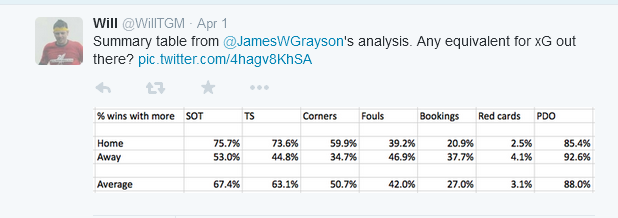
 Yep. I concur. It took a bit of wrangling to create charts that I was broadly content with but I can show the impact that shot dominance has on both goals and points, from the perspective of the home and away teams, and it indicates a familiar bias towards the home team. I should add that each data point is bucketed and incorporates the two nearest values either side of the given number, that the higher figures are excluded and that small samples still persist towards the edge of the charts. Regardless, here's what we see with goals:
Yep. I concur. It took a bit of wrangling to create charts that I was broadly content with but I can show the impact that shot dominance has on both goals and points, from the perspective of the home and away teams, and it indicates a familiar bias towards the home team. I should add that each data point is bucketed and incorporates the two nearest values either side of the given number, that the higher figures are excluded and that small samples still persist towards the edge of the charts. Regardless, here's what we see with goals: 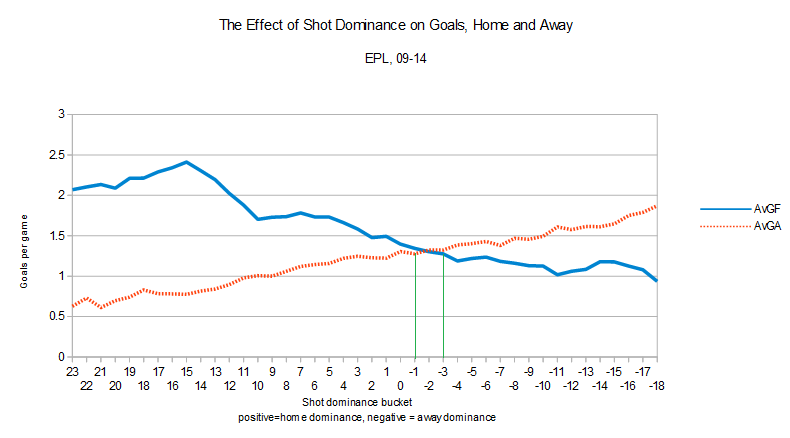 Without any bias, we would expect the value lines to cross at zero. In fact, they cross somewhere between minus one and minus three shots, to the cost of the away team. What this suggests is that before a ball is even kicked, an away team can probably expect to have to generate around two shots extra per game to create a par outcome. Home field advantage has been shown to have clear significance in previous studies, and it is borne out here. We can also see the same effect on points:
Without any bias, we would expect the value lines to cross at zero. In fact, they cross somewhere between minus one and minus three shots, to the cost of the away team. What this suggests is that before a ball is even kicked, an away team can probably expect to have to generate around two shots extra per game to create a par outcome. Home field advantage has been shown to have clear significance in previous studies, and it is borne out here. We can also see the same effect on points: 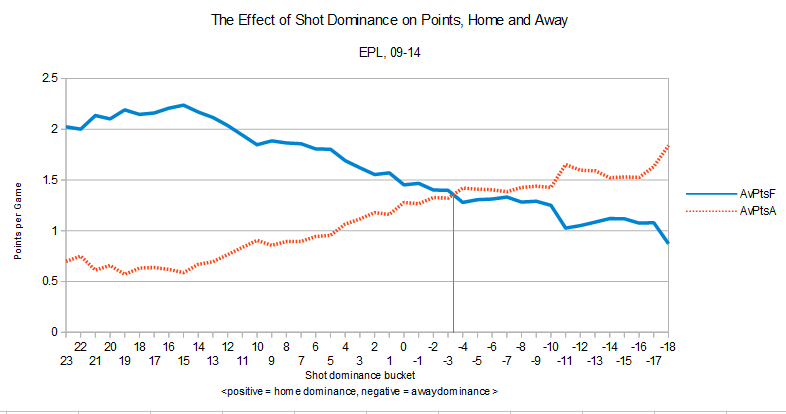 This time the effect is arguably larger, with a clear crossing point at a shade over minus three shots. Indeed, here the away team only seems to gain a particularly significant potential advantage when it exceeds a ten shot dominance. Compare with the perceived points expectation a home advantage of ten shots confers. [A curio in the sample is that the rate of goals (2.79 per game) is closely matched to the rate of points (2.74 per game). If you refer back to the graphs, they track quite nicely.] There are clear implications here for work with shots. We already intuit that all shots are not born equal and there is significant discourse in the analytics community as to whether methods of separating and defining them are sufficiently meritorious so as to favour complex modelling over straightforward counting metrics. In many cases a preference is linked to whichever method one has devoted time and work towards or even whether or not a purposeful endgame is being visualised. There are still many simple elements that can be examined with basic counted data and with some of the modelling understandably shrouded, it can be hard to be definitive as to which the most effective and predictive metrics truly are. Okay, okay, enough with the graphs and analytics, how about some weekend review? Personal highlights this weekend were the two Gomis finishes. I challenge anyone not to enjoy his first volleyed attempt and the marvellous composure to languidly lob in his second was Berbatov-esque. Swansea continue to defy my, and maybe the shot watchers, expectations. In their last ten matches, they have exceeded 11 shots only once yet have amassed 16 points. Five of those matches were against members of the current top seven so they can feel well pleased to be maximising their returns, at least for now. In a similar vein, Everton have started to pick up results despite being beaten down recently on the shot count. This was a trick they performed a few times at a similar stage last season before eventually their challenge for the top four (!) petered out. Though this time it is more about securing comfort in mid-table, it is hard to know whether they have just managed to stabilise after some inequitable results prior or if they're just finally getting a share of good fortune. Elsewhere, many things remain similar. Chelsea eked out another narrow win to remain adequately ahead and Arsenal and Man Utd again put forward solid claims to be the strongest teams in the land, at least based on recent form. Arsenal have become adept at preventing shots on target (last 11 games only once over 4 shots on target conceded, 8 against Tottenham) and swept past a faltering Liverpool. I have suggested more than once in this column that I felt Liverpool's challenge would end up in the top four but the combination of Utd's sudden improvement and again poor form in a crunch game has apparently killed them off. Five games ago Utd recorded 30 shots including 10 on target against Sunderland. In that game and the four subsequent games, they have only conceded 30 shots and nine on target in total. Their success is built largely on restriction of the opposition and with Herrera, Carrick, Mata and Fellaini now surrounding Rooney, they appear to have chanced upon an attacking potency they formerly lacked. Obligatory Tottenham bit A bravura performance from Paulinho led Tottenham to another comfortable victory against a battling but ultimately limited Burnley side. Recently maligned by fans, he responded magnificently by rounding the keeper to open the scoring then contributed fully as Harry Kane ran riot scoring five, Eriksen chipped in with a couple more and Tottenham ran out 9-1 winners. At least that's a version of reality that would sit a little better than a grindy 0-0 against a well organised Burnley team, who on recent showings look reasonably well set to climb away from the relegation zone. But, no! Their point, whilst deservedly earned, paled in comparision to QPR, Sunderland and Leicester's three, each of which was backed up by solid attacking numbers. Hey, if Gus Poyet could rescue Sunderland last season, given the fixture list they overcame, then it's impossible to state that any team in this league will be pulling their rip-cord any time soon. Thanks for reading! ~~~~~~~~~~~~~~~~~~~~~~~~~~~~~~~~~~~~ Find me here on Twitter: @jair1970
This time the effect is arguably larger, with a clear crossing point at a shade over minus three shots. Indeed, here the away team only seems to gain a particularly significant potential advantage when it exceeds a ten shot dominance. Compare with the perceived points expectation a home advantage of ten shots confers. [A curio in the sample is that the rate of goals (2.79 per game) is closely matched to the rate of points (2.74 per game). If you refer back to the graphs, they track quite nicely.] There are clear implications here for work with shots. We already intuit that all shots are not born equal and there is significant discourse in the analytics community as to whether methods of separating and defining them are sufficiently meritorious so as to favour complex modelling over straightforward counting metrics. In many cases a preference is linked to whichever method one has devoted time and work towards or even whether or not a purposeful endgame is being visualised. There are still many simple elements that can be examined with basic counted data and with some of the modelling understandably shrouded, it can be hard to be definitive as to which the most effective and predictive metrics truly are. Okay, okay, enough with the graphs and analytics, how about some weekend review? Personal highlights this weekend were the two Gomis finishes. I challenge anyone not to enjoy his first volleyed attempt and the marvellous composure to languidly lob in his second was Berbatov-esque. Swansea continue to defy my, and maybe the shot watchers, expectations. In their last ten matches, they have exceeded 11 shots only once yet have amassed 16 points. Five of those matches were against members of the current top seven so they can feel well pleased to be maximising their returns, at least for now. In a similar vein, Everton have started to pick up results despite being beaten down recently on the shot count. This was a trick they performed a few times at a similar stage last season before eventually their challenge for the top four (!) petered out. Though this time it is more about securing comfort in mid-table, it is hard to know whether they have just managed to stabilise after some inequitable results prior or if they're just finally getting a share of good fortune. Elsewhere, many things remain similar. Chelsea eked out another narrow win to remain adequately ahead and Arsenal and Man Utd again put forward solid claims to be the strongest teams in the land, at least based on recent form. Arsenal have become adept at preventing shots on target (last 11 games only once over 4 shots on target conceded, 8 against Tottenham) and swept past a faltering Liverpool. I have suggested more than once in this column that I felt Liverpool's challenge would end up in the top four but the combination of Utd's sudden improvement and again poor form in a crunch game has apparently killed them off. Five games ago Utd recorded 30 shots including 10 on target against Sunderland. In that game and the four subsequent games, they have only conceded 30 shots and nine on target in total. Their success is built largely on restriction of the opposition and with Herrera, Carrick, Mata and Fellaini now surrounding Rooney, they appear to have chanced upon an attacking potency they formerly lacked. Obligatory Tottenham bit A bravura performance from Paulinho led Tottenham to another comfortable victory against a battling but ultimately limited Burnley side. Recently maligned by fans, he responded magnificently by rounding the keeper to open the scoring then contributed fully as Harry Kane ran riot scoring five, Eriksen chipped in with a couple more and Tottenham ran out 9-1 winners. At least that's a version of reality that would sit a little better than a grindy 0-0 against a well organised Burnley team, who on recent showings look reasonably well set to climb away from the relegation zone. But, no! Their point, whilst deservedly earned, paled in comparision to QPR, Sunderland and Leicester's three, each of which was backed up by solid attacking numbers. Hey, if Gus Poyet could rescue Sunderland last season, given the fixture list they overcame, then it's impossible to state that any team in this league will be pulling their rip-cord any time soon. Thanks for reading! ~~~~~~~~~~~~~~~~~~~~~~~~~~~~~~~~~~~~ Find me here on Twitter: @jair1970
